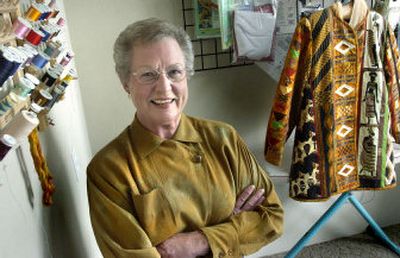Quilter enjoys challenge of creating original pieces

Unlike some other art forms, quilting started as a way to warm the body, not lift the mind.
By combining multiple layers of cloth, quilters kept cold at bay and, as a side benefit, when women gathered to share quilting ideas, the craft helped them create a sense of community. What was once called a quilting bee now could be better termed, said quilter Judi Conroy, “a holistic gathering.”
Over the years, the craft of quilting became a fine art, decorating walls instead of covering beds.
Conroy, 65, works out of her basement, using fabric as her palette. She first used a treadle sewing machine in grade school, then took home economics/sewing classes in high school. Her mother made clothes for Conroy and her sisters, and when Conroy married 45 years ago, she made clothing for her husband, Bob, then, her children and theirs.
She has her own version of the “holistic gathering,” learning from fellow textile artists and members of Quilting in the Inland Empire Guild at Sew Uniquely You, 10220 N. Nevada St., where they gather to swap stories and support one another’s creative endeavors.
Many of the quilters recently displayed their work at the Kress Gallery in River Park Square, where the work represented things like landscapes, birds and dancing figures. “We got a great response from the public,” said Conroy, “a lot of people couldn’t believe that fabric could be created into such beautiful works of art.” Conroy’s abstract piece titled “Elegance” included marble-dyed fabric and beads.
Conroy’s “Village Coat” has given her the most satisfaction. She began it a year ago and it took four months to complete. Using an array of stitching techniques, she combined more than 30 colorful African-inspired patterns and prints of women, children, animals, huts and foliage into the quilted coat.
Conroy has just begun to delve into the world of textile art.
“I like challenges and there’s probably some correlation between constructing something in fabric, working jigsaw puzzles and math that’s a turn-on for me,” she said.
“It’s exciting to see what the end results will be when you dye fabrics and then use them to create an original piece with one-of-a-kind materials.”
One thing she discovered is that “mistakes, or unintentional designs work beautifully under the guise of art. Being a person with an anal gene, this grants a lot of freedom.”
Slowly but surely, Conroy is moving in the direction of what she really wants to do, which is to create landscape art with fabric.
“We’ve taken some pictures while we’ve traveled and I think they could translate to fabric nicely,” she said.